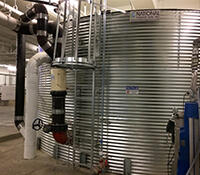What is Low Impact Development (LID)?
Low Impact Development (LID) is a stormwater management approach that mimics nature’s hydrologic cycle by designing new development to slow down stormwater runoff (attenuation), increase groundwater recharge (infiltration), and reduce pollutant loads in stormwater runoff by filtering water through plants and soils (treatment). LID strategies include many techniques to reduce stormwater runoff from developed land, including:
rain gardens

stream buffers

rainwater cisterns

tree planting

green roofs

pervious pavement

native plant landscaping

LID Projects on the UC Berkeley Campus
The booklet, Reinventing Stormwater: A Tour of the UC Berkeley Campus, highlights innovative design features of LID water infrastructures on campus.
LID Regulations
UC Berkeley is required to treat stormwater from new development and redevelopment using LID techniques.
LID Resources
Check out CASQA's LID resources to learn how to design and build stormwater treatment facilities.
There are many LID resources out there on the web. Here are just a few to get you started:


